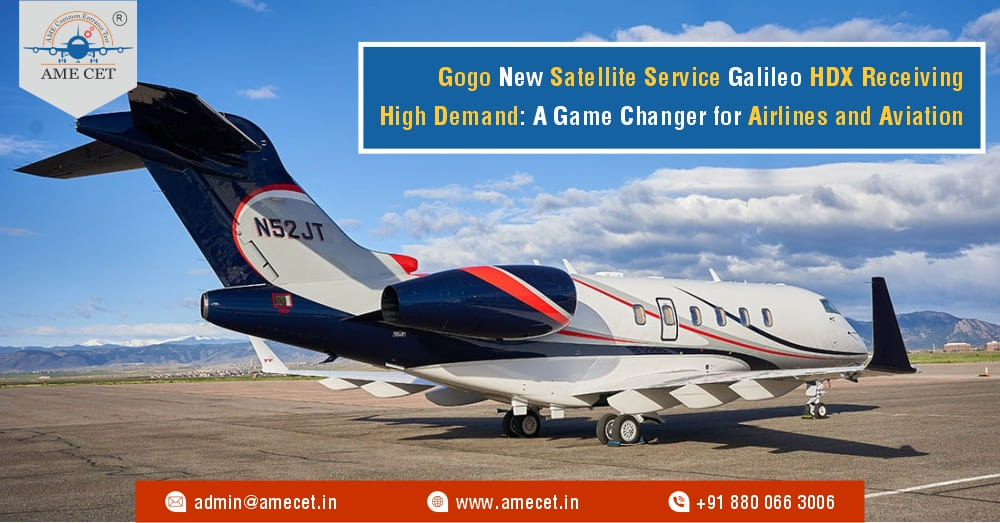
In a significant development for the aviation industry, Gogo's new satellite service, Galileo HDX, is experiencing high demand from airlines seeking to enhance passenger experience through improved in-flight connectivity. As airlines like Air India, Vistara, and Indigo continue to expand their fleets and modernize their services, the integration of advanced satellite technology becomes increasingly crucial. This shift not only impacts passenger satisfaction but also has far-reaching implications for various aspects of the aviation sector, including aircraft maintenance engineering, pilot training, and airport management.
The Role of Satellite Technology in Aviation
Gogo's Galileo HDX service represents a leap forward in aeronautical technology, delivering high-speed internet connectivity that meets the expectations of today’s tech-savvy travelers. Passengers now expect seamless connectivity while in the air, akin to their experiences on the ground. This has led airlines to prioritize investments in in-flight services that include robust internet access, which directly influences customer loyalty and overall satisfaction.
As airlines upgrade their fleets with new aircraft equipped with Gogo’s services, the implications for aircraft maintenance engineering become apparent. Enhanced connectivity allows for more efficient aircraft monitoring and maintenance scheduling. Real-time data transmission enables ground staff to receive crucial information about aircraft performance, which can streamline the aircraft maintenance process and reduce downtime.
Impact on Ground Staff Training
The introduction of new technologies like Galileo HDX necessitates an overhaul in ground staff training programs. With advanced systems in place, ground personnel must be equipped to handle the intricacies of new communication technologies. Training programs will need to incorporate modules on how to utilize satellite data for operational efficiency, ensuring that the entire airport management ecosystem is aligned with technological advancements.
Airlines such as Air India and Vistara are likely to invest in comprehensive training for their ground staff, focusing on how to maximize the benefits of satellite connectivity in their operations. This includes ensuring that ground staff can effectively troubleshoot connectivity issues, manage equipment, and coordinate with cabin crew and maintenance teams for a seamless travel experience.
Elevating Pilot Training and Operations
In addition to enhancing passenger services, Gogo's Galileo HDX also impacts pilot training. With improved connectivity, pilots can access real-time weather data, navigational updates, and other critical information that can enhance flight safety and efficiency. As a result, aeronautical engineering programs will increasingly focus on integrating these technological advancements into their curricula, ensuring that future pilots are well-versed in utilizing such tools.
Training institutions like AMECET and AMES (Aircraft Maintenance Engineering School) may adapt their programs to include satellite communication systems, emphasizing the importance of data analysis in flight operations. This shift will better prepare pilots for the modern demands of aviation and improve overall operational safety.
The Role of Cabin Crew
The cabin crew also stands to benefit from Gogo's advancements. Enhanced connectivity can facilitate better communication between pilots and cabin crew, allowing for more effective coordination during flights. This is particularly important during emergency situations, where timely information can make a significant difference.
Airlines like Indigo and Vistara are likely to incorporate these technologies into their cabin crew training programs, ensuring that staff are trained to leverage satellite communication effectively. Such training could encompass protocols for handling passenger inquiries about connectivity and troubleshooting common issues, ultimately enhancing the passenger experience.
The Future of Airlines
The high demand for Gogo's Galileo HDX service underscores a broader trend within the aviation industry: the need for innovation and adaptation. As airlines strive to remain competitive, investing in cutting-edge technologies will be crucial. The implementation of satellite services not only meets passenger expectations but also fosters an environment of operational excellence.
Furthermore, as airlines expand their networks and fleet sizes, effective airport management becomes essential. Airports must adapt to the increased demand for high-quality connectivity by upgrading their infrastructure to support advanced satellite communication systems. This includes ensuring that airport operations can handle the influx of data generated by connected aircraft, which may require investments in IT systems and staff training.
Conclusion
Gogo’s new satellite service, Galileo HDX, is poised to revolutionize the aviation industry by addressing the growing demand for in-flight connectivity. The implications of this technology extend beyond mere passenger satisfaction; it touches on critical areas such as aircraft maintenance engineering, pilot and cabin crew training, and overall airport management. As airlines like Air India, Vistara, and Indigo embrace these advancements, the entire ecosystem of aviation is set to benefit.
With the aviation industry continuing to recover and evolve, Gogo's Galileo HDX represents a significant step forward in ensuring that airlines can meet the expectations of modern travelers. The high demand for this service is a clear indication that the future of aviation is not only about flying passengers from one destination to another but also about enhancing their experience through technology and connectivity. As the industry moves forward, it will be exciting to see how these changes shape the future of air travel
Category
-
Aircraft Maintenance Engineering (DGCA) (55)
-
Cabin Crew (1)
-
Aircraft Maintenance Engineer (AME) (1)
-
Aerospace Engineering (3)
-
Commercial Pilot License(CPL) (81)
-
(188)
-
Aircraft Maintenance Engineering (BTech/BE) (4)
-
Aeronautical Engineering (2)
-
Airport Management (5)
-
Aircraft Maintenance Engineering (EASA) (11)
-
Airport Ground Staff (1)
-
B.Sc. in Aviation (1)
-
AME CET (5)
